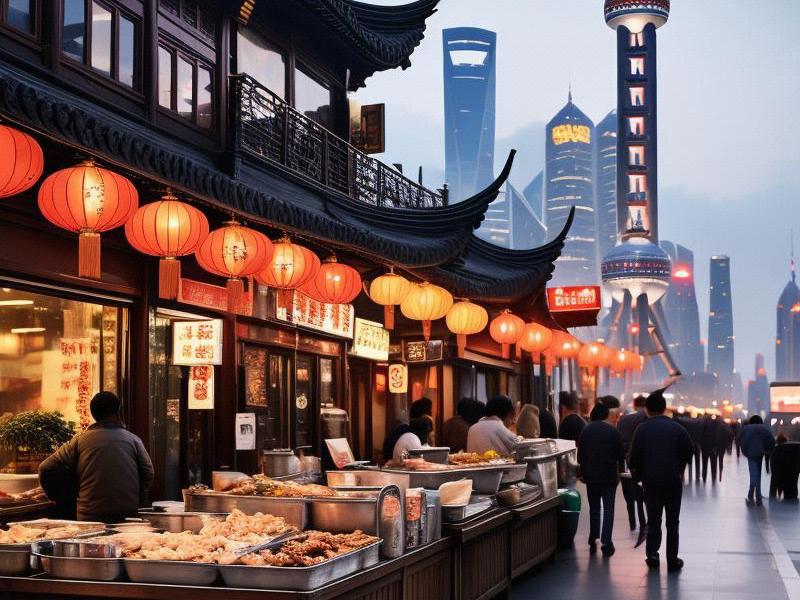Shanghai, a bustling metropolis on the banks of the Huangpu River, is renowned not only for its towering skyscrapers and modern skyline but also for its rich and vibrant street food culture. This culinary tradition, deeply rooted in the city's history, offers a sensory journey through flavors that reflect the essence of Shanghai and its people.

Nestled between the ancient alleys of the Old City God Temple and the modern facades of Pudong, Shanghai's street food scene is a tapestry woven with threads of tradition and innovation. It is a living, breathing testament to the city's ability to blend the old with the new, creating a unique gastronomic experience that has captivated locals and tourists alike.
The heart of Shanghai's street food culture beats in places like Nanxiang Mantou Dian (Nanxiang Steamed Bun Shop) and the bustling night markets of Shiliupu and Zhapu Road. These are not just places to eat; they are cultural landmarks where the city's culinary heritage comes alive.
Nanxiang Mantou Dian, a century-old establishment, is a must-visit for those seeking an authentic taste of Shanghai. Renowned for its xiaolongbao (soup dumplings), the shop has maintained its reputation for quality and authenticity. The delicate dumplings, with their translucent wrappers and savory broth, are a culinary masterpiece. The process of making these dumplings is an art form, requiring precision and skill. The dough is rolled to perfection, the filling is carefully prepared, and the dumplings are sealed with a flick of the wrist. When bitten into, the soup bursts forth, offering a delightful contrast to the rich meat filling.
The night markets of Shanghai are another highlight of the city's street food scene. Shiliupu Night Market, one of the largest in the city, is a haven for food lovers. Here, the air is filled with the aroma of sizzling skewers, the sweetness of candied hawthorn, and the savory scent of stinky tofu. Each stall offers a unique taste of Shanghai, from the crispy spring rolls to the chewy rice cakes. The market is a vibrant tapestry of colors and sounds, with vendors calling out their offerings and customers haggling over prices.
上海龙凤论坛爱宝贝419
Zhaojiabang Road, a historic street in the former French Concession, is another treasure trove of street food. This area has been revitalized in recent years, with many old buildings being transformed into trendy restaurants and cafes. However, the street still retains its charm, with traditional snack shops serving up classic Shanghai delicacies. One such shop is Lao Bian dumpling restaurant, known for its handmade dumplings and hearty soups. The restaurant's simple yet elegant decor reflects the essence of old Shanghai, while the food offers a taste of the city's culinary heritage.
The diversity of Shanghai's street food is a reflection of the city's history as a melting pot of cultures. Influences from Jiangsu, Zhejiang, and other regions have all contributed to the development of Shanghai's culinary traditions. This fusion of flavors is evident in dishes like the sweet and sour spare ribs, which combine the tangy sweetness of Jiangsu cuisine with the rich umami of Shanghai's own style.
The street food culture of Shanghai is not just about the food; it is also a way of life. It reflects the city's fast-paced yet deeply rooted traditions, where the past and present coexist harmoniously. The street food vendors, often seen as the backbone of this culture, are more than just food preparers; they are storytellers, preserving the history and essence of Shanghai through their cooking.
上海花千坊爱上海
In recent years, there has been a growing interest in sustainable and healthy eating. This trend has also influenced Shanghai's street food scene, with many vendors offering healthier options. For instance, there are now more vegetable-based skewers and lighter, less greasy versions of traditional snacks. This shift towards health-conscious eating is a testament to the adaptability of Shanghai's street food culture, which continues to evolve while maintaining its core identity.
The impact of Shanghai's street food culture extends beyond the city's borders. It has become a symbol of the city's vibrancy and creativity, attracting food enthusiasts and culinary explorers from around the world. International media outlets have taken note of Shanghai's street food scene, with articles and documentaries highlighting its unique charm and the stories behind the food.
However, the rapid urbanization of Shanghai poses challenges to the preservation of its street food culture. As the city continues to grow and modernize, many traditional street food stalls are being replaced by high-end restaurants and commercial developments. This has led to concerns about the loss of this integral part of Shanghai's cultural heritage.
上海娱乐
Efforts are being made to preserve and promote Shanghai's street food culture. The government has introduced initiatives to protect traditional food stalls and support local vendors. Community groups and food enthusiasts are also playing a crucial role in documenting and sharing the stories of Shanghai's street food, ensuring that these culinary traditions are not lost to future generations.
In conclusion, the vibrant street food culture of Shanghai is a reflection of the city's rich history, diverse influences, and dynamic spirit. It is a testament to the resilience and adaptability of Shanghai's culinary traditions, which continue to evolve while maintaining their core identity. From the iconic xiaolongbao of Nanxiang Mantou Dian to the sizzling skewers of Shiliupu Night Market, Shanghai's street food offers a taste of the city's soul, a journey through flavors that capture the essence of Shanghai and its people.
As we savor the delicious treats of Shanghai's street food, we are reminded of the city's ability to blend tradition with innovation, creating a unique gastronomic experience that is both timeless and contemporary. The street food culture of Shanghai is not just about the food; it is a way of life, a living testament to the city's history and its people's spirit.